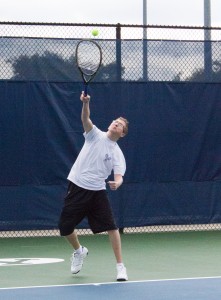You have that old tennis racket your dear old Aunt Marge gave to you three Christmases ago, but you just can’t seem to get yourself to use it. It’s laid slumbering in the back of your closet, steadily collecting its second layer of dust.
Tennis can have a steep learning curve for many beginners, but BYU head tennis coach Brad Pearce said the most important thing is to stick with it.
“The most important thing to remember, even with members of the BYU team, is to focus on consistency,” Pearce said. “If all else fails, keep the ball in the court.”

Tennis can seem confusing to the beginner picking up a racket for the first time; however, rest assured it is not as bad as it seems.
The sport of tennis is a blend of both physical and mental prowess. A major factor of the game is focused on the players’ technique.
Pearce said getting a good start in tennis begins with learning the proper grips, strokes and going out with the right mentality.
Tennis.com contains a detailed list of each of the common grips found in tennis including the continental grip, eastern forehand grip and the semi-western forehand grip. For beginners, it’s best to start with the continental grip, which is simply grabbing your racket as if you were giving it a handshake.
Love, deuce, ad in and ad out are just a few of the terms found in tennis. It is easy to get discouraged by the load of jargon that accompanies the sport.
Tennis has been around for ages, and thus its scoring is steeped in tradition. History itself is still a little unsure as to the actual origins of tennis. The first records of tennis date back to ancient Italy and France. The game became more official in France, where the adoption of equipment and rules made the game-play more unified.
Oxforddictionaries.com says the tennis term “love” came from simply playing because you love the game. If the game is tied at zero, the players aren’t playing because they have a real winning advantag but because they love the sport. Another theory surrounding the term “love” also is that it comes from the French word “l’oeuf,” which means egg because of the similarity of an egg and the number zero.
After zero points, or love, the first point is counted as 15, the second as 30, the third as 40, and the fourth is the winning point, only if the player has a two-point advantage. It is speculated that medieval French tennis was scored by using the hand of a clock, but 40 is used rather than 45 because it is simply easier to say.
If the score is 40-40, or deuce, the game resorts to advantage scoring.
Advantage scoring, or ad scoring for short, is relatively simple. After the game points are at deuce, if the serve scores the next point, it is ‘ad in.’ If the receiver scores the point then it is ‘ad out,’ meaning the advantage is not in the servers’ favor. To win, you must score two consecutive points.
Tennis games are won when either player scores either four points with a two-point lead, or if they win in advantage scoring. A tennis set consists of a player winning at least six games with a two-point advantage. If both players win six games, the set goes to a tie-breaker game. The winner of the game wins the set.
Matches are won by the player who can win the most sets. Tennis matches are usually set up to include an odd number of sets to ensure a winner.
“Tennis is also one of the great networking sports,” Pearce said. “Deals in businesses or professional relationship are often formed on the tennis courts.Tennis is a lifetime sport. You don’t need a lot of people to play, and you can play it with a spouse, child or date.”
The BYU men’s tennis season gets underway this January, and Coach Pearce invites any interested tennis players to come out and see the stories sport in action.




